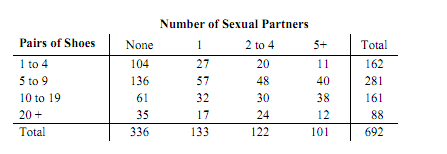Data collected from the STATS 10x class survey one semester included responses to questions on the number of different sexual partners and on the number of pairs of shoes the student owns. Students could choose not to answer the question on number of sexual partners if they did not want to. 692 students answered both of the questions and their answers are cross-classified in the table below.

Use the table above to answer the following:
(a) What percentage of the students has had no sexual partners?
(b) (i) Of those students who had no sexual partners, what proportion owned only 1 to 4 pairs of shoes? (ii) Of those students who had 1 or more sexual partners, what proportion owned only 1 to 4 pairs of shoes? (iii) Can we conclude that the having slept with at least one person decreases a student's chance of owning only 1 to 4 pairs of shoes? Briefly justify your answer.
(c) Which one of the following statements is the odd one out? Briefly justify your choice.
(1) Given that a student has had one sexual partner, what is the probability that they owned at least 20 pairs of shoes?
(2) What proportion of students that have had one sexual partner own at least 20 pairs of shoes?
(3) What is the probability that a student owns more than 20 pairs of shoes given that they have had one sexual partner?
(4) What is the probability that a student who owns more than 20 pairs of shoes has had one sexual partner?
(d) 1098 students filled in the class survey in the first semester. Assume that these are a representative sample of all stage 1 students in the first semester. Name two forms of non- sampling error that could affect the answer to the question on number of sexual partners.